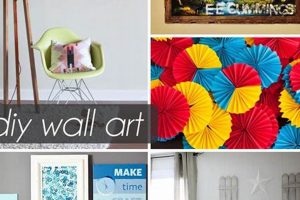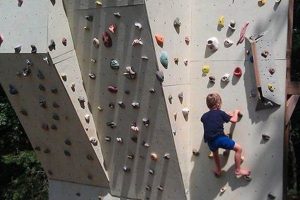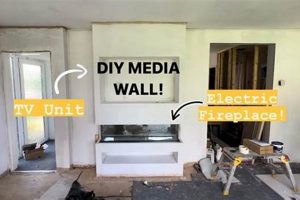A self-constructed panel affixed to the wall behind a bed, serving as a decorative and supportive element, is the subject of this discussion. This structure often replaces or supplements a traditional bed frame headboard, offering design flexibility and space-saving advantages. Examples range from simple upholstered panels to more elaborate constructions incorporating storage or lighting.
Utilizing a custom-built support offers a unique opportunity to personalize bedroom aesthetics. Its benefits include tailored dimensions, material selection, and design integration to complement existing dcor. Furthermore, its wall-mounted nature can free up floor space, particularly advantageous in smaller rooms. The practice of attaching headboards to walls has evolved from purely functional support to a design-centric approach reflecting individual style and maximizing room usability.
The following sections will delve into material selection, construction techniques, and design considerations for creating a custom bedroom accent. These elements will empower individuals to craft a unique and functional bedroom feature that reflects their personal style and optimizes their space.
Construction Considerations for a Wall-Affixed Bed Head
The following recommendations address key elements involved in creating a structurally sound and aesthetically pleasing wall-mounted headboard.
Tip 1: Precise Measurement is Essential: Prior to any cutting or assembly, accurately measure the width of the bed frame and the desired height of the headboard. Account for potential baseboard obstructions and desired reveal above the mattress.
Tip 2: Secure Mounting Hardware Selection: Employ appropriate mounting hardware based on the weight of the finished headboard and the wall construction. Stud finders are critical for locating wall studs; when studs are not available, use heavy-duty drywall anchors rated for the intended load.
Tip 3: Material Choice Dictates Durability: Select materials suitable for the intended aesthetic and expected wear. Solid wood offers robustness, while upholstered panels provide comfort. Consider the long-term performance characteristics of each material in relation to humidity and temperature fluctuations.
Tip 4: Ensure Proper Wall Preparation: Verify the wall surface is clean, level, and free from imperfections before installation. Minor imperfections can be corrected with patching compounds; significant unevenness may necessitate shimming the headboard for a flush mount.
Tip 5: Conceal Fasteners for a Clean Finish: Employ methods to conceal fasteners such as countersinking screws and using wood filler, or employing a French cleat system for a floating appearance.
Tip 6: Consider Integrated Features: Plan for any integrated features, such as lighting or shelving, during the design phase. This allows for the proper routing of wires and secure attachment of shelves before final installation.
Adhering to these tips ensures a stable, visually appealing, and long-lasting installation. Careful planning and execution are paramount for a successful project.
The subsequent sections will offer advice on styling and design to complete the project.
1. Material Selection
Material selection is a foundational element in the creation of a wall-mounted headboard. The choice of materials significantly impacts the aesthetic, durability, and overall structural integrity of the finished piece. Careful consideration must be given to the properties of each potential material to ensure suitability for both the design and the intended use.
- Wood Species and Characteristics
The selection of wood species dictates the headboard’s visual appeal, strength, and resistance to wear. Hardwoods like oak and maple offer durability and classic aesthetics, while softwoods like pine are more economical but require greater care in finishing. Grain patterns, color variations, and inherent resistance to moisture or insects all contribute to the suitability of a particular wood for this application.
- Upholstery Fabrics and Textures
When incorporating upholstery, fabric choice is crucial for comfort and style. Linen, velvet, and synthetic materials each offer distinct tactile experiences and visual characteristics. Durability, stain resistance, and ease of cleaning are practical considerations that directly impact the longevity and maintenance requirements of the upholstered headboard.
- Metal and Hardware Components
Metal elements, whether for framing, decorative accents, or mounting hardware, contribute to both the structural integrity and visual design. Steel offers robust support, while aluminum provides a lightweight alternative. The finish and corrosion resistance of metal components are important factors to consider, especially in environments with high humidity. The choice of screws, bolts, and brackets is also vital for secure attachment and longevity of the piece.
- Composite Materials and Alternatives
Alternatives such as plywood, MDF (Medium-Density Fiberboard), and reclaimed materials present options for achieving specific design goals while considering cost or environmental impact. Plywood offers layered strength, while MDF provides a smooth surface for painting or veneering. Reclaimed materials introduce unique character and sustainable design elements, but require careful preparation and assessment of structural integrity.
Ultimately, the selection of materials represents a series of interconnected decisions that shape the final product. A thoughtful approach, considering both aesthetic preferences and practical requirements, will result in a durable, visually appealing, and functionally effective wall-mounted headboard. The interplay of wood, fabric, metal, and alternative materials enables the creation of a diverse range of styles tailored to individual preferences and spatial requirements.
2. Mounting Security
Mounting security is a paramount consideration in the construction of a self-assembled, wall-affixed bed head. It directly impacts the structural integrity, safety, and longevity of the project, warranting meticulous attention to detail in its planning and execution. The method by which the headboard is attached to the wall is not merely an afterthought, but an integral design element influencing the overall success of the endeavor.
- Wall Stud Location and Utilization
Locating and utilizing wall studs is the most structurally sound method for securing a wall-mounted headboard. Studs provide a solid anchor point, capable of bearing significant weight without compromising the integrity of the wall. The spacing of studs, typically 16 or 24 inches on center, dictates the potential width and mounting points of the headboard. Failure to utilize studs necessitates the use of alternative anchoring methods, which may offer reduced load-bearing capacity.
- Anchor Selection and Load Capacity
When wall studs are inaccessible, anchor selection becomes critical. Various types of drywall anchors exist, each rated for a specific load capacity. Toggle bolts, molly bolts, and heavy-duty plastic anchors offer varying degrees of support. It is imperative to select anchors appropriate for the weight of the headboard, factoring in a safety margin to account for potential dynamic loads. Overestimating the required load capacity is advisable to ensure a secure and stable installation.
- Attachment Method and Hardware
The specific method of attachment, whether direct screwing, the use of a French cleat system, or other hanging mechanisms, influences the distribution of weight and the overall stability of the headboard. High-quality hardware, including screws, bolts, and brackets, is essential for a secure connection. The length and gauge of screws must be appropriate for the thickness of the headboard material and the depth of the wall stud or anchor. A poorly chosen attachment method can lead to instability, sagging, or even complete failure of the mounting.
- Wall Material Compatibility
The type of wall material, whether drywall, plaster, or concrete, dictates the appropriate anchoring techniques. Drywall requires specialized anchors, while plaster may necessitate the use of lath screws. Concrete walls require masonry anchors and specialized drilling equipment. Incorrect anchor selection for the wall material can result in inadequate holding power and a compromised installation. Prior assessment of the wall composition is crucial for ensuring compatibility and selecting the appropriate mounting hardware.
In conclusion, achieving mounting security in a self-constructed, wall-affixed bed head necessitates a comprehensive understanding of wall structure, anchor types, and load-bearing principles. A deliberate approach to these factors ensures a stable, safe, and long-lasting installation, enhancing the aesthetic and functional value of the project. Disregarding these considerations can lead to potentially hazardous outcomes, underscoring the importance of prioritizing mounting security throughout the design and construction phases.
3. Design Aesthetics
Design aesthetics plays a crucial role in the creation of a self-constructed, wall-affixed headboard. The visual appeal of the headboard dictates how well it integrates into the overall bedroom decor, impacting the atmosphere and perceived value of the space. Careful consideration of design principles transforms a functional element into a personalized statement. A minimalist headboard with clean lines and neutral colors, for example, enhances a modern bedroom. Conversely, a tufted, upholstered headboard introduces a sense of luxury and comfort to a traditional setting. The choice of materials, textures, and patterns directly influences the overall design aesthetic and contributes to the desired ambiance.
The interplay between design aesthetics and practical functionality is significant. While the visual appearance is paramount, the headboard’s design should also consider user comfort and ease of maintenance. An overly ornate headboard might be visually appealing but difficult to clean, or a headboard that is too tall may feel imposing in a small room. A well-designed headboard strikes a balance between aesthetic appeal and practical considerations, enhancing the user experience without compromising functionality. Practical applications of this understanding extend to material selection. For instance, choosing stain-resistant fabrics for an upholstered headboard reduces the burden of maintenance. Similarly, selecting a wood species with a natural resistance to wear and tear increases the longevity of the piece.
In summary, design aesthetics forms an integral component of a self-built, wall-mounted headboard, contributing to its overall visual appeal and functionality. Challenges arise when aesthetic desires conflict with practical considerations or budgetary constraints. A thoughtful approach to design, considering both the visual impact and the user experience, is essential for creating a successful and harmonious addition to the bedroom. The selection of a wall affixed bedhead contributes to the overall bedroom decoration and creates the ambiance of the entire interior room.
4. Size Dimensions
The size dimensions of a self-constructed, wall-affixed headboard are critical determinants of its visual impact, functional utility, and overall integration within the bedroom space. Precise measurements and careful consideration of scale are essential for a successful project.
- Width and Bed Frame Compatibility
The width of the headboard must align precisely with the width of the bed frame to create a cohesive and balanced aesthetic. Underestimation results in a visually incomplete look, while overestimation can obstruct bedside tables or create an ungainly appearance. Accurate measurement of the bed frame, accounting for any existing side rails or protruding elements, is therefore paramount.
- Height and Proportionality
The height of the headboard influences the perceived scale and prominence of the bed within the room. A headboard that is too short may appear insignificant, while an excessively tall headboard can overwhelm the space, particularly in smaller bedrooms. Proportionality to the height of the bed frame and the overall dimensions of the room is crucial for achieving visual harmony. Consideration should also be given to the height of bedside tables and lamps to ensure a balanced composition.
- Thickness and Projection from Wall
The thickness of the headboard dictates its visual weight and the extent to which it projects from the wall. A very thin headboard might appear flimsy, while a bulky headboard can intrude excessively into the room. The desired thickness is influenced by the chosen materials, design style, and any incorporated features such as shelving or lighting. Careful consideration of the depth and weight of materials is required.
- Spatial Constraints and Room Size
The overall size of the bedroom imposes limitations on the dimensions of the headboard. In smaller rooms, oversized headboards can exacerbate feelings of confinement. Conversely, in larger rooms, diminutive headboards may appear disproportionate. A careful assessment of the available space and the existing furniture layout is essential for determining the optimal size and dimensions of the self-constructed element.
These considerations of width, height, thickness, and overall scale represent the central dimensional elements to optimize in the design and construction of the do-it-yourself wall-mounted bed head. Accurate measurement and proportional assessment are critical components in the planning phase to ensure the finished structure complements both the bedroom design and dimensions.
5. Cost Efficiency
Cost efficiency is a primary motivator for undertaking a do-it-yourself wall-mounted headboard project. By circumventing retail markups and standard manufacturing processes, individuals can realize significant savings compared to purchasing pre-made alternatives.
- Material Sourcing and Affordability
The selection of materials directly impacts the overall cost. Utilizing reclaimed wood, repurposing existing materials, or opting for budget-friendly alternatives like MDF or plywood significantly reduces expenses compared to purchasing premium hardwoods or expensive upholstery fabrics. Strategic sourcing from salvage yards, online marketplaces, or discount retailers further enhances affordability.
- Labor Cost Avoidance
One of the most substantial cost savings stems from performing the labor oneself. Professional carpentry or upholstery services can represent a considerable expense. The do-it-yourself approach eliminates these labor costs, making the project significantly more economical. Time invested in learning new skills contributes to long-term savings by enabling future projects.
- Customization vs. Standardization
Pre-manufactured headboards adhere to standardized sizes and designs, often lacking the specific dimensions or aesthetic preferences desired by the individual. The ability to customize every aspect of the headboard, from size and shape to material and finish, without incurring premium charges for bespoke work, is a key cost-saving advantage. Customization guarantees a personalized design for minimal expenditure.
- Tool Investment and Long-Term Value
While initial tool investments might be necessary, these tools offer long-term value, facilitating numerous future projects. The acquisition of essential tools, such as a saw, drill, and measuring devices, represents a one-time expense that amortizes over time, reducing the overall cost per project and empowering individuals to undertake other home improvement tasks.
The synergy between these cost-saving factors underscores the economic benefits of undertaking a do-it-yourself wall-mounted headboard project. By strategically managing material sourcing, avoiding labor costs, embracing customization, and viewing tool investments as long-term assets, individuals can achieve a stylish and personalized bedroom upgrade at a fraction of the retail price.
6. Installation Simplicity
The ease of installation constitutes a significant factor in the appeal and feasibility of a self-assembled, wall-affixed bed head. A project’s perceived difficulty directly affects the likelihood of its completion. Complex installations deter novice or time-constrained individuals, thereby impacting the adoption rate. Conversely, straightforward installation procedures enhance project accessibility, encouraging participation and expanding the user base.
Reduced complexity positively correlates with decreased material waste and minimizes the potential for errors. A simple design, for instance, often requires fewer specialized tools and skills, reducing the learning curve and the risk of costly mistakes. Pre-drilled mounting holes, clearly labeled components, and readily available online tutorials contribute to an intuitive installation process. Consider a design employing a French cleat system, offering straightforward wall mounting compared to individually anchoring multiple points. This simplicity accelerates project completion, fosters a sense of accomplishment, and minimizes frustration.
Ultimately, installation simplicity forms a critical component of the overall value proposition for a DIY bed head project. A user-friendly installation process lowers the barrier to entry, attracting a wider audience and increasing the likelihood of a successful and satisfying outcome. Projects that prioritize ease of assembly often achieve higher completion rates and generate greater user satisfaction, thus enhancing the popularity of DIY endeavors. Balancing complexity with simplicity requires thoughtful design.
Frequently Asked Questions
This section addresses common inquiries regarding the design, construction, and installation of a self-assembled headboard affixed to the wall.
Question 1: What tools are essential for constructing a wall-mounted headboard?
Essential tools include a measuring tape, level, stud finder, drill with various bits, saw (circular or hand saw), sandpaper, and appropriate safety equipment (eye protection, gloves). The specific tool set may vary depending on the chosen materials and design.
Question 2: How is the weight capacity of wall anchors determined?
Wall anchor weight capacity is typically indicated on the packaging. It is crucial to select anchors rated for a load exceeding the headboard’s weight, factoring in a safety margin. Consult manufacturer specifications and consider the wall material (drywall, plaster, etc.) when making this determination.
Question 3: What are the advantages of using a French cleat for mounting?
A French cleat offers a secure and easily adjustable mounting solution. It distributes weight evenly along the wall, simplifying alignment and allowing for minor adjustments after installation. It also provides a clean, concealed mounting method.
Question 4: How can the risk of damage to the wall during installation be minimized?
Precise measurement and careful marking of drilling locations reduce the likelihood of errors. Employing the correct drill bits for the wall material, using a level to ensure straight mounting, and avoiding excessive force during drilling or screwing minimizes wall damage.
Question 5: What types of finishes are recommended for a wooden headboard?
Recommended finishes depend on the desired aesthetic and level of protection. Options include paint, stain, varnish, lacquer, and oil-based finishes. Each offers varying degrees of durability, moisture resistance, and ease of application. Research and testing prior to applying any finish is advised.
Question 6: How does one ensure the headboard is level after mounting?
Use a level during the mounting process to ensure the headboard is perfectly horizontal. Minor adjustments can be made using shims placed behind the headboard before final securing. Regularly check the level at multiple points along the headboard’s top edge.
The answers provided serve as a foundation for understanding the key considerations involved in building and installing a self-constructed, wall-affixed bed head. Further research and careful planning are advised prior to commencement of the project.
The next section will elaborate on common pitfalls.
In Conclusion
This article provided a comprehensive overview of the “diy wall mounted headboard,” exploring its design considerations, material selection, mounting techniques, and cost-effectiveness. Careful planning, precise execution, and informed decision-making are essential for a successful project. A properly constructed support contributes significantly to both the aesthetic appeal and functional comfort of a bedroom space.
Individuals are encouraged to approach this endeavor with meticulous attention to detail, recognizing that the resulting structure will serve as a prominent focal point within the room. The benefits derived from a well-executed project extend beyond mere cost savings, encompassing personalized design, enhanced spatial efficiency, and lasting satisfaction. The application of these principles will create a functional and aesthetically pleasing wall-mounted addition.







